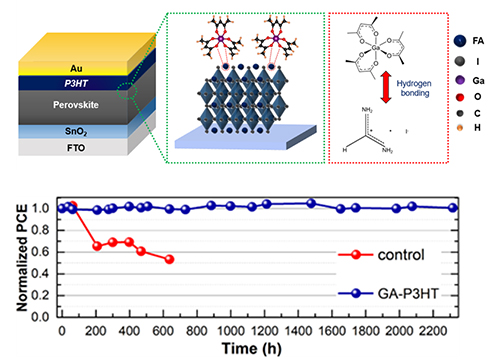New solar cells boasting both safety and efficiency
High-performance P3HT-based perovskite solar cells developed
Team led by Prof. Noh Jun-hong develops spontaneous interface engineering technology
Results published in Energy & Environmental Science

The research team led by Professor Noh Jun-hong of the School of Civil, Environmental and Architectural Engineering at Korea University succeeded in developing high-performance P3HT-based perovskite solar cells based on a spontaneous interface engineering strategy that significantly enhances the efficiency and stability of existing halide perovskite solar cells. The results were published in Energy & Environmental Science (impact factor: 30.289), a world-leading journal in energy and environment, on April 22 (GMT +1).
* Perovskite solar cells: A perovskite solar cell includes a perovskite-structured halide-based material as its light absorption layer. Perovskite solar cells have been drawing interest as next-generation solar cells.
* P3HT: Poly(3-hexylthiophene) is a hole transporting material, and holes are positively-charged particles that transport current.
In the study, gallium acetylacetonate was introduced as a new additive to the P3HT solution. The team proposed spontaneous interface engineering, in which P3HT is spin-coated on the perovskite surface and spontaneously interacts with defects. The spontaneous interface engineering process promotes chemical interactions between gallium acetylacetonate and perovskite when P3HT is coated on the perovskite surface, thereby effectively controlling defects on the perovskite surface without requiring additional processes. The P3HT-based perovskite solar cells obtained using spontaneous interface engineering exhibited outstanding stability against humidity due to the hydrophobic nature of gallium acetylacetonate and enhanced interfacial properties. The results with the perovskite solar cells achieved under the spontaneous interface engineering approach were published in Energy & Environmental Science.
- Title of paper: Spontaneous interface engineering for dopant-free poly(3-hexylthiophene) perovskite solar cells with efficiency over 24%
- Authors: Jeong Min-ju (first author, Korea University), Noh Jun-hong (corresponding author, Korea University), Jung Eui-hyuk (co-corresponding author, Korea University),
정민주 박사과정 (제1저자, 고려대학교)
Several challenges had to be overcome for the commercialization of perovskite solar cells. Hole transporting materials typically used in high-efficiency perovskite solar cells are expensive and require hygroscopic additives to enhance conductivity. However, the dopants cause degradation of the perovskite layer and negatively affect long-term stability, preventing the commercialization of perovskite solar cells.
* Hole transporting material: Spiro-OMeTAD and PTAA are commonly used.
* Hygroscopic additive: In general, hygroscopic additives, such as Li-TFSI and tert-butyl pyridine, are added in small amounts.
The problems of hole transporting materials can be solved using P3HT, which is more affordable and has better thermal stability. In particular, P3HT itself is highly conductive, which means that hygroscopic additives are not required. Until now, high-efficiency perovskite solar cells have been made with hole transporting materials, and P3HT-based perovskite solar cells have been less preferred due to their lower power conversion efficiency. Many defects exist at the interface between perovskite and P3HT, resulting in non-radiative recombination. This hinders the performance of P3HT-based perovskite solar cells.
* Non-radiative recombination: Non-radiative recombination is where charge carriers recombine with holes due to surface defects, and release energy in the form of heat.
To resolve the problems between perovskite and P3HT, the team proposed a spontaneous interface engineering approach, under which a new additive is introduced to the P3HT solution to effectively control interfacial contact and defects through spontaneous chemical reactions between the additive and perovskite when the P3HT is coated on the perovskite surface. When the additive-containing hole transporting material is coated on the perovskite surface, the additive spontaneously controls surface defects and enhances interfacial contact. The oxygen atoms in gallium acetylacetonate control perovskite surface defects through hydrogen bonding with unbound cations. As a result, the hole transporting material gets coated on the perovskite surface without additional processes. Accordingly, the approach was proven effective for controlling surface defects of the perovskite layer.
The P3HT-based perovskite solar cells developed using the spontaneous interface engineering approach demonstrated outstanding performance and stability. The device achieved the highest power conversion efficiency among dopant-free P3HT-based perovskite solar cells reported to date. Defects at the perovskite surface were controlled through spontaneous chemical reactions between perovskite and gallium acetylacetonate in P3HT, which contributed to suppressing non-radiative recombination. The reduced non-radiative recombination in turn enhanced the open-circuit voltage, allowing the device to achieve the high power conversion efficiency of over 24%. In addition, the device showed superior stability against moisture for 2000 hours under 85% relative humidity at room temperature, retaining at least 98% of initial efficiency performance.
* Open-circuit voltage: This is the voltage when current does not flow in the solar cell, and is directly related to solar cell efficiency.
Professor Noh Jun-hong said, “Existing hole transporting materials used to fabricate high-efficiency perovskite solar cells were not suitable for commercialization in terms of cost and stability. The significance of this study lies in fabricating a device with a high power conversion efficiency of 24% using the more promising P3HT as a hole transporting material.”
One of the researchers said, “Previously, additional processes were needed to control defects at the perovskite surface. However, such processes lead to higher costs, and even hinder perovskite commercialization. The proposed spontaneous interface engineering approach is more suitable for the commercialization of perovskite solar cells as it forms the hole transporting layer without additional processes and, at the same time, controls defects at the perovskite surface.”
The results were published in Energy & Environmental Science on April 22. The study was supported by the Mid-Career Researcher Program of the National Research Foundation of Korea under the Ministry of Science and ICT, and Korea Electric Power Corporation (KEPCO).




